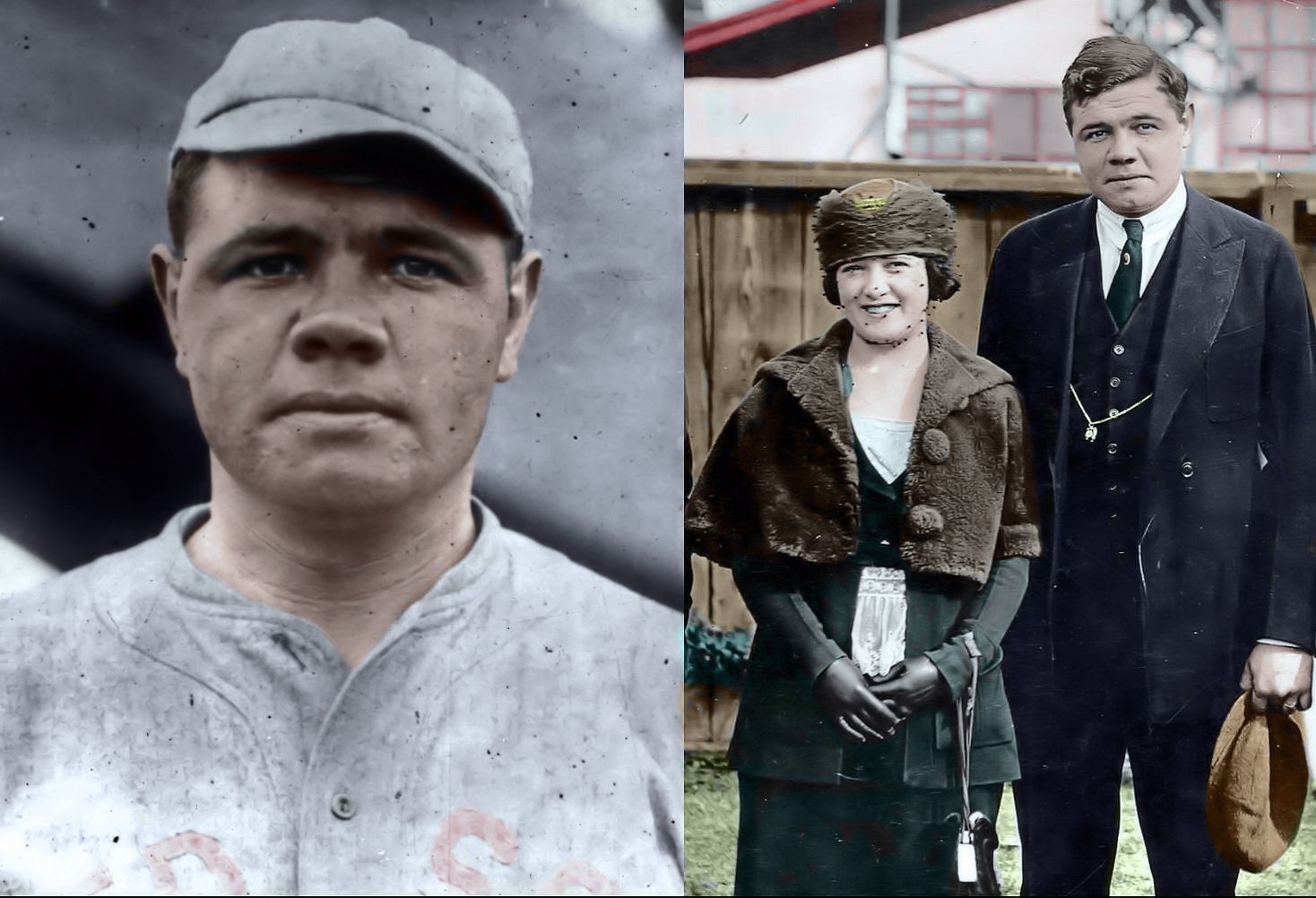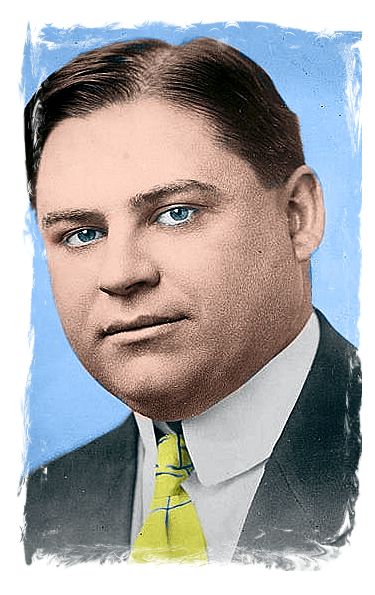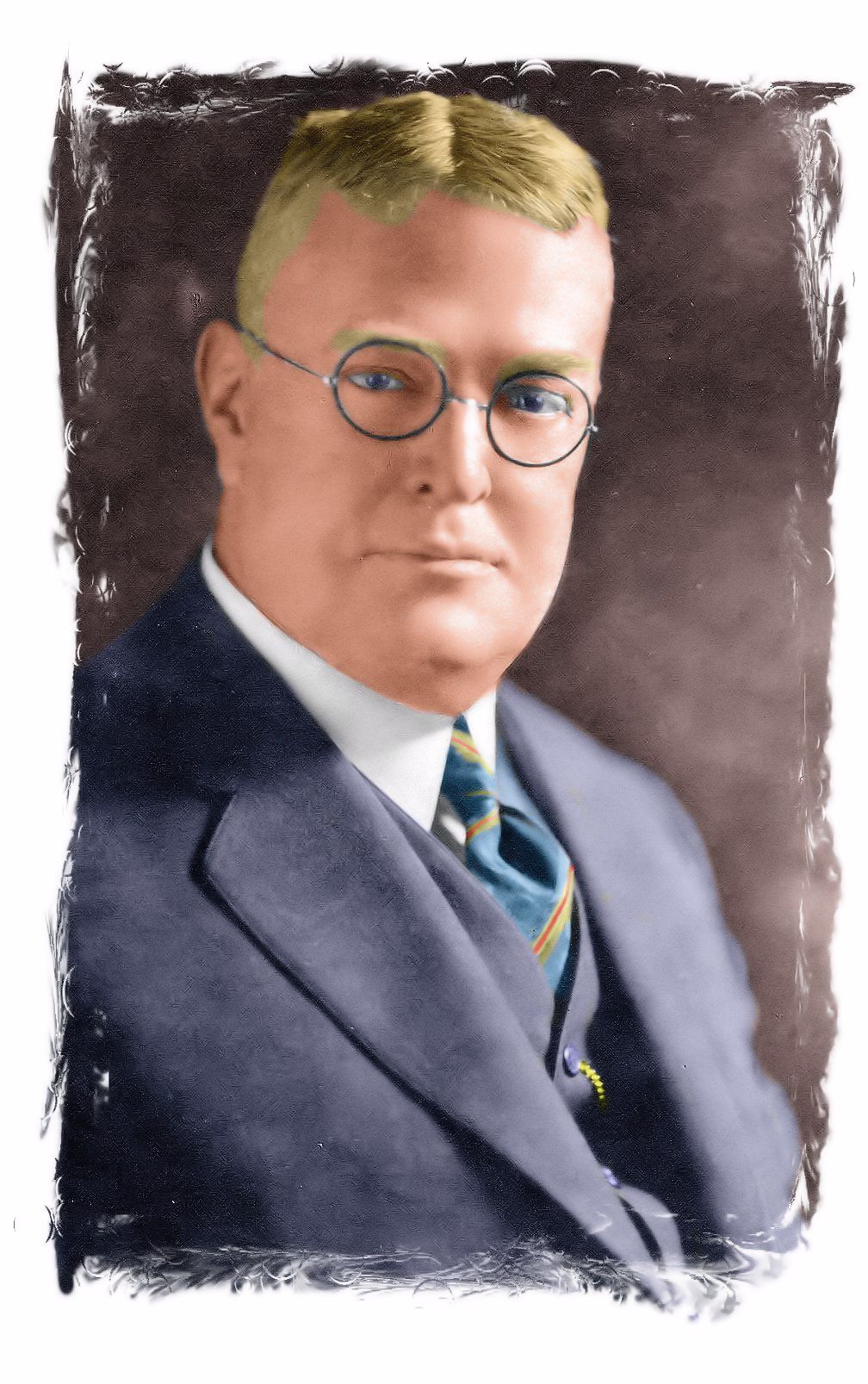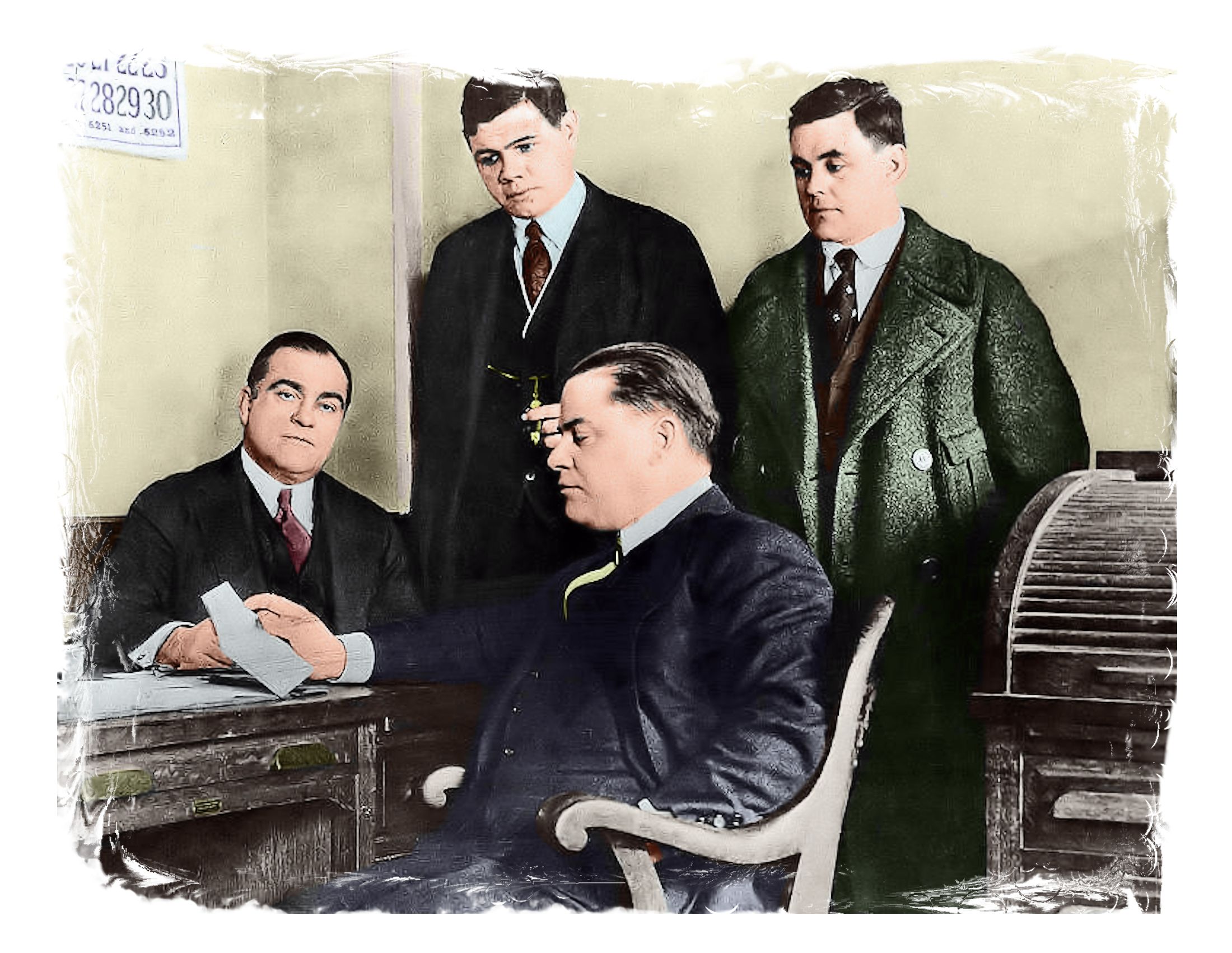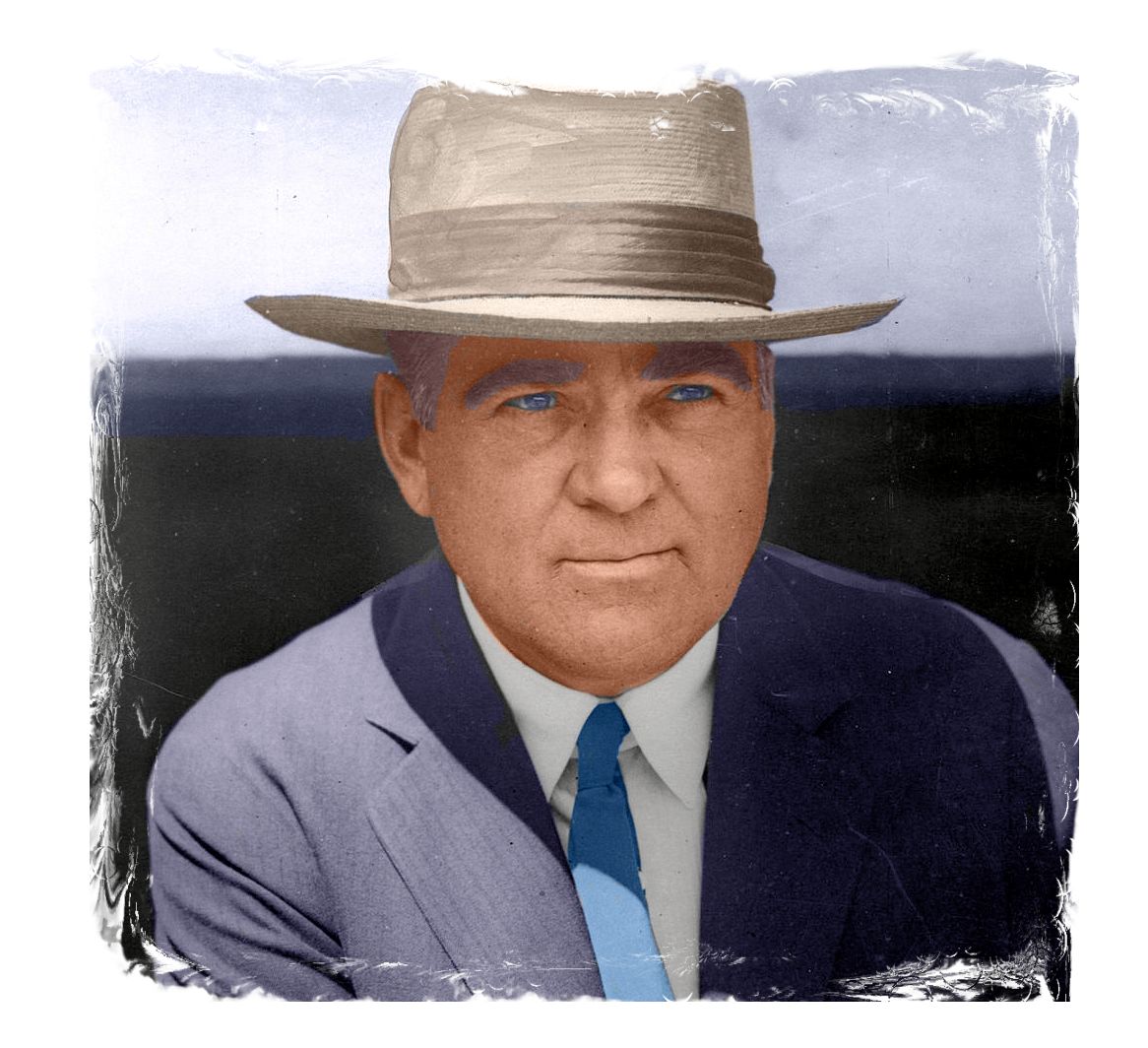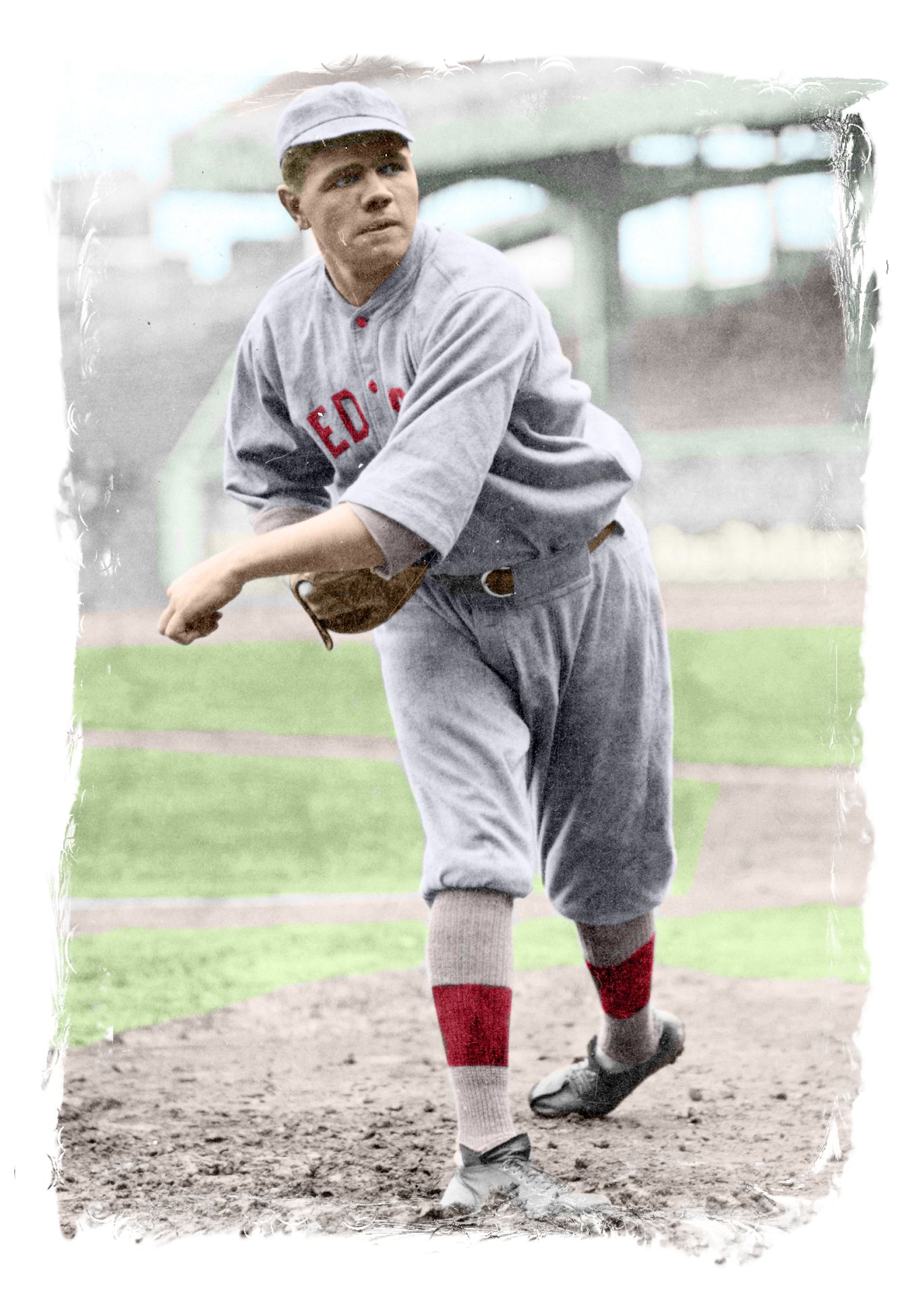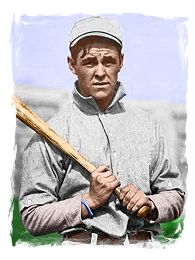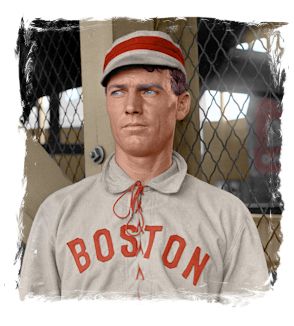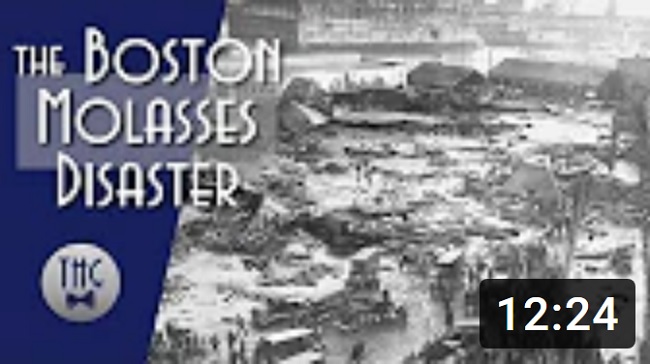|
1919 BOSTON RED SOX ...
Winning the 1918 World Series, served to make Red Sox owner, Harry Frazee think he was a very important player in major league baseball. Other team owners viewed him as an interloper in their exclusive club, while Frazee saw himself as being qualified to lead baseball into a new era. Nobody became more offended by him then American League President, Ban Johnson. Johnson had never wanted Frazee in the league, and that never became more true than after Frazee and the Red Sox won the championship in 1918.
Frazee reveled in the growing controversy, considering any notoriety to be good publicity. He made the comment that he was thinking about selling the Red Sox for $1 million and even announced he was considering a move to Braves Field. He felt that Fenway Park real estate was just becoming too valuable to be used for a ballpark. Nothing came from either plan, but again the publicity he considered to be a plus. He then joined forces with New York Giants owner, Harry Hempstead to lead the charge to replace Ban Johnson as head of the National Baseball Commission, a three-man panel that Johnson led, and replace him with former president William Howard Taft to be the Commissioner. Johnson hated the National League and the New York Giants in particular, and the coup served to infuriate him even more. Frazee knew taking on Johnson was risky and, as he left for the 1919 league meeting in Chicago, he told reporters that he would rather lose the Red Sox then the buried by Ban Johnson. On the surface, the league meeting was uneventful, as Johnson trimmed the 1919 schedule to 140 games and cut rosters to save money. Frazee disagreed, but went along. He also wanted to pay the players during spring training, a plan that the tight-fisted Johnson was totally against, and it failed to pass.
Behind the scenes, Frazee had gained support from some of the other owners in the American League. Charles Comiskey, of the White Sox and Colonel Jacob Ruppert, of the Yankees, were close friends of Frazee and moved in the same circles. They were all annoyed when they learned that Johnson had recently propped up the Cleveland franchise with $58,000 of his own money. For that alone they wanted Johnson removed. Johnson told reporters after the meeting, that Frazee was allowing gambling at Fenway Park which was against the league constitution, and on that alone, he could revoke his membership in the American League. Johnson had given lip service to the gambling problem for years, but had never taken any action. The problem was no worse in Boston that it was anywhere else, and the comment served no purpose, except to take a shot at Frazee. Johnson, in his actions, hoped Frazee would get upset enough and sell the Red Sox, because he knew that the courts would never force Frazee to sell his business. Johnson wanted Frazee out and Frazee was determined to stay. The first few months of the standoff passed quietly, as plans for the 1919 season occupied both men. In December 1918, Frazee struck a deal with Jacob Ruppert to sell some of his surplus, including Duffy Lewis, Ernie Shore and Dutch Leonard to the Yankees for pitcher Ray Caldwell, outfielder Frank Gilhooley, pitcher Slim Love, catcher Roxy Walters and $15,000. The Yankees had money and no players of any worth, while Frazee had players to spare, and so the deal was consummated. The deal gave Frazee ready cash in case he should fall into a protracted legal battle with Johnson, and perhaps, most significantly, assured the allegiance of the Yankee owners to his cause. The move didn't hurt the Red Sox for only Dutch Leonard had contributed in 1918. The acquisition of Joe Bush and Amos Strunk, along with the emergence of Babe Ruth as an outfielder, made Duffy Lewis and Ernie Shore expendable. Before spring training started infielder, Fred Thomas and catcher, Sam Agnew were also sold for cash. Still the 1919 Red Sox looked strong. They still had there four top starters from 1918, in Babe Ruth, Carl Mays, Sam Jones and Joe Bush. In Amos Strunk, Harry Hooper, Wally Schang, Stuffy McInnis and Everett Scott, they still had formidable position players. Frazee then traded for Ossie Vitt from the Tigers, to fill a hole at third-base. The club was so well-stocked that the hero of the 1918 World Series, George Whiteman, was just released. Although Whiteman played professional baseball for another decade, he never made another appearance in a major-league uniform.
Manager Ed Barrow looked forward to having Babe Ruth return to the pitching rotation, pinch-hitting and taking an occasional turn in the outfield. The Babe had other ideas. After doing double duty, he felt he was underpaid. In spite of the fact that he had already signed a contract for the 1919 season in the amount of $7000, he threatened to hold out, telling Frazee he wanted a one-year contract for $15,000 or a three-year contract for $30,000. He also stated that he did not want to pitch anymore. Frazee simply told him to get out of his office. Every other player also wanted more money and Frazee played hardball with them all. Harry Hooper said he was making more from ranching that he was from playing baseball and threatened to retire. Ruth also threatened to retire and become a boxer or an actor. Frazee stated to the newspapers that if Ruth did not want to play, he would be traded. Spring training began in mid-March and the season was scheduled to start on April 23rd. The delay gave all parties a chance to work out their differences. The New York Giants agreed to also train in Tampa, Florida with the Red Sox, to take advantage of the Babe's drawing power in exhibition games, but threatened not to share the facilities if Ruth was not signed. Both men got nervous, and Frazee and Ruth agreed to a three-year $30,000 deal. Ruth pitched only a few innings in a scrimmage during spring training, but when the exhibition season started on April 4th, he played left-field and continued his prodigious hitting. He smacked one of his longest home runs, estimated between 500 and 600 feet, which is still marked today with a plaque at the University of Tampa.
As the team barnstormed north, crowds of people turned out to see Babe Ruth hit. Boston's pitching continued to impress manager Barrow and he saw no reason to send the Babe to the mound. Barrow was not convinced that Ruth's hitting was genuine, thinking that if he played every day, he would hit into a hundred doubleplays, as during the spring he had done most of his damage again second line pitchers. As opening day approached, Hooper, who was named team captain, and Scott lobbied Barrow to keep Babe in the outfield. He reluctantly agreed, but cautioned that if the Babe slumped, he would have to pitch. Barrow hadn't forgotten that most of Ruth's hitting in 1918 came in streaks and that he struggled against lefties. He also felt that Fenway Park's spacious right-field, robbed him of much of his home run power. The Red Sox won the World Series in 1918 because of the strength of Ruth's arm and not his work at the plate. Nobody expected him to hit home runs as frequently and as far as he would do in the future. Ruth's work on the field was not only Barrow's only worry. His off field behavior had an effect on team chemistry and it was a greater concern. He proved undependable in 1918 and jumped the club twice, and then injured his thumb during the World Series. Relying on him became increasingly risky. Still when the Red Sox opened the season, they were the favorites to win the pennant. Things went downhill for Carl Mays in 1919. He ran into a lengthy streak of bad luck on the mound, as the slumping Red Sox gave him almost no run support. Over a 15-day period in June, Mays lost three games by a combined score of 8-0. The last straw came on July 13th, during a game against the White Sox. When Eddie Collins tried to steal second base, catcher Wally Schangís throw hit Mays in the head. At the end of the inning, the pitcher stormed off the mound, left the team and headed back to Boston. 1919 also wasn't as kind to Sam Jones and he finished the season 12-20 with an inflated 3.75 ERA. Several headlines mentioned his wildness and wobbling. Jones got more work than anyone else on the staff, but others pitched better. He did dominate Washington, throwing three shutouts in a row before losing in the last matchup. Although the 1919 season was a disappointment for the Red Sox, Everett Scott hit a career-high .278 and led all American League shortstops in fielding. Stuffy McInnis honed his first base defense to a point of near-infallibility. In 1919, he made seven errors in 118 games for a .995 fielding average and batted .305
The Red Sox won their first game with the New York Yankees at the Polo Grounds on April 23rd, with Ruth hitting a home run over the head of Duffy Lewis, and Carl Mays pitching a 10 to 0 shutout. The Red Sox won their second game with 8 to 0 shutout and Babe blasting a triple. His hot hitting continued the next day as he doubled and tripled off Walter Johnson in Washington, while Mays won his second game by a score of 6 to 5. After losing the second game in Washington, the Sox took the third game on April 30th by a 6 to 1 score, behind newcomer Ray Caldwell. Harry Hooper went 4 for 5 and was the hot hitter in the early going, having made eight hits in 22 at bats. Babe Ruth's ceaseless adventures concerned Barrow so much that he sat in the hotel lobby one night and waited for him until 4 AM before he gave up. He then paid a hotel porter the next evening, to play detective and report when Ruth came in. The porter knocked on Barrow's door at 6 AM. Barrow and Ruth confronted one another after that, and had to be separated. Ruth was suspended for a game and the Red Sox won anyway by a score of 6 to 1 on April 30th. The celebrated incident cooled later that day and the two reached an understanding and an arrangement. Ruth was reinstated just in time for the Red Sox home opener. The Sox lost three of the four games played against the Yankees in the opening series at Fenway Park.
In the first game on May 1st, although the Babe doubled in his first at bat, he played poorly in the outfield and the Red Sox lost by a 7 to 3 score. The next day he also went hitless and the Red Sox lost again. Babe was only batting .200 Barrow and Frazee then announced that Ruth would return to the pitching rotation and only play in the outfield occasionally. The move paid off as the Babe, in spite of only pitching once in spring training, beat the Yankees 3 to 2 on May 3rd, and helped his own cause by doubling in a run. But the Babe was back in left field a few days later and didn't pitch another game for two weeks. On May 6th, Ray Caldwell won his second game as a member of the Red Sox, shutting out Washington at Fenway, 2 to 0 and giving up only three hits. Two days later Sam Jones shut out the Nats again, 3-0. The Red Sox took off to play a western road trip, starting in Chicago. There they lost 2 of 3, with Eddie Cicotte beating Carl Mays in a pitcher's duel on May 14th, 1-0, and striking out Babe twice. The winning run came on a Red Sox error and a double by Joe Jackson.
Babe won the only game that went the Red Sox way on May 15th. Stuffy McInnis doubled home Jack Barry to give the Sox a 12 inning sloppy victory, 6-5. Joe Bush started the game and left after the first inning with a sore arm. Ruth was summoned in from left field to start the second inning and pitched the rest of the game. He gave up five runs and 13 hits. Then in St. Louis, the Browns took 2 of 3 from the Sox who were batting .200 as a team in the two series. The only game they won was the third victory for Babe, 6 to 4 on May 20th. The Sox scored all their runs in the second inning. With two runs in and the bases full, Babe deposited the ball on the other side of the right field bleacher wall for a grandslam. But the team lost three straight in Detroit and three more in Cleveland. Sox pitching was at fault as their mound-men could not hold the leads the batters had given them early in the game. Mays was the worst culprit who couldn't win a game on the trip and Joe Bush who was nursing a sore arm, was ineffective. The batters were at their worst when Sam Jones pitched and the only pitcher to win games was Babe Ruth. In Philadelphia, the Red Sox finally figured out how to win. On May 29th, Mays limited the A's to four hits, three of which came in the first three innings and won 7 to 1. In the third inning Babe's double with the bases loaded, scored two runners and two more runs came in and Stuffy McInnis' double. The Sox and A's split a Memorial Day doubleheader on May 30th. The first game was a 10-6 easy victory for Babe, who won his fourth game. But he also knocked out three hits. In the second game, the Sox had amassed a 3-1 lead thanks to Babe's tremendous home run with Amos Strunk aboard. The ball not only cleared the right field fence of Shibe Park, but sailed over the roof of one of the houses across the street. Unfortunately Herb Pennock could not hold the lead for the Sox and the A's won 4-3. The final game of the series went the Red Sox way. They won 6 to 4 because of sloppy fielding by the Athletics. Amos Strunk collected three hits and drove in two runs for Boston.
June started with the Sox ending their road trip with a visit to Washington. Their they took two of the three games they played. Everett Scott (.340 BA) drove in the winning run in the ninth inning to give the Sox a 4 to 3 victory on June 3rd. In the final game of the series which the Sox won, 8 to 3, Babe hit a triple that was hit so high, Nats' outfielder Mike Menosky couldn't find it for a while. Straightened out, it probably would have been good for two home runs. Babe (.273 BA) had two hits, good for three RBIs. The Sox ended the road trip with only seven wins of the nineteen games they played. They returned to Boston in 6th place, 7 1/2 games behind the league-leading White Sox. Against Detroit at Fenway, Babe won his fifth straight game, 2 to 1 on June 5th, but wrenched his knee in a scramble trying to get back to third base. Harry Hooper came through with a couple of doubles and Del Gainer had three singles. Babe came back a couple of days later and blasted a three-run homer high into the right field bleachers, but the Tigers hit Ray Caldwell, George Winn and Carl Mays for 16 hits and a 10-5 win. Against the White Sox at Fenway, each team took two games. Red Sox batters were not hitting. Eddie Cicotte won his seventh straight for Chicago in the first game and Lefty Williams shut them out in the second game. In the third game, on June 12th, the bats came alive and the Red Sox won 4 to 0. Babe broke the game open, doubling with runners on second and third. Herb Pennock pitched beautifully and didn't allow any baserunners to reach second base, after giving up just three hits. Wally Schang's triple, with the bases loaded, gave the Red Sox a 6 to 1 decision in the fourth game. Schang's drive was one of three hits which, combined with four free passes, gave Boston five runs in the fifth inning. But the Indians came in and took four straight games. Seven runs were all the Red Sox could score in the four games. Stuffy McInnis' ninth inning triple tied up the first game in the ninth inning and sent the game into overtime. The Indians scored two in the 13th inning and the Sox rallied in their half of the inning, but fell one run short, losing 4-3. The Sox were shutout on three hits in the second game, losing 1-0. Carl Mays was the losing pitcher. His teammates had not scored a run for him in over 40 innings of work. He was the only Sox player performing to his usual standard. From May 13th through June 16th, he gave up only twelve runs in five starts, yet lost all five games because of the Red Sox atrocious defense and failure to score a single run. The temperamental pitcher became irate and in Philadelphia threw a ball at a heckler in the stands. For that Ban Johnson fined him $100, but Mays refused to pay. In a June 17th doubleheader, the Indians won both games, again by one run each, 4 to 3 and 3 to 2. Babe homered into the right field bleachers in the sixth inning of the second game, but wrenched his knee again. After losing another one run game, this time to the Browns, making it five straight losses, Carl Mays pitched another great game and finally won a one-run decision, 2 to 1 on June 19th. The two runs the Sox scored came on a double off the bank by Babe, a walk and a two run base hit by Everett Scott a few moments later. On June 20th, Babe beat the Browns, 3 to 1 and knocked in the winning run with a triple. In that game, he gave up eight hits and walked eight batters, but St. Louis left 13 men on base. Behind him, Sox infielders turned three doubleplays. Against Washington on June 24th, the Sox were down 2-0 in the seventh inning. Babe then slugged another homer far into the right field bleachers and the Sox scored two runs, to tie the game and scored three more led by Harry Hooper, an inning later, to notch a 5 to 2, come-from-behind win. The next day, Babe pitched and was hammered, 8-3, in the first game of a doubleheader, but the Sox came back, behind Sam Jones and took the second game from Walter Johnson, 1-0. Jones gave up four scattered hits and Johnson five. Hooper scored the only run of the game on his base hit, a sacrifice bunt and a single by Amos Strunk. The Sox (22-28) finished the homestand in 6th place, 11 games behind the White Sox. The Babe (6-2, 3.28 ERA) was tired. He was overworked, played almost every game that he didn't pitch, batting .303 with six home runs, and had a sore knee. Manager Barrow didn't pitch him again for three weeks. Babe was also causing trouble in the clubhouse, lobbying to have Jack Barry resume being the manager. Harry Hooper also wanted the job and accustomed to being the club's offensive star, was becoming increasingly jealous of the attention being paid to the Babe. Frazee and Barrow tried to get some on-field elp before the season slipped away, by purchasing Bill Lamar from the Yankees, and over the remainder of the year, he hit nearly .300 On June 27th, Barry and Amos Strunk were traded to the Philadelphia Athletics for 26-year-old Braggo Roth and 22-year-old secondbaseman Red Shannon. Moving Barry helped quiet the dissension, but he refused to report and retired. When the trade was made, Roth was batting .323 for the last place A's and out-slugging Ruth. The Sox traveled down to New York for five games and lost three. Carl Mays (5-9, 2.22 ERA) threw both games of a doubleheader against the Yankees on June 28th. The first game was a 2-0 shutout, but he lost the second game 4-1. Babe had four hits on the day, in six times up, slugging out two doubles in the first game. He finally had emerged from his slump, raising his average to .319, and started cracking out home runs at a record pace. He slugged his 7th homer in the first game of a June 30th doubleheader, but the Sox lost both games. Braggo Roth got hurt and the Red Sox (24-31) fell further behind and finished the month with a 11-16 record, in sixth place and twelve games behind the first-place White Sox. As a team, the Red Sox were batting .240 and their opponents were hitting .268
July started with a loss in Philadelphia, followed by two wins. The two teams next met again for three consecutive doubleheaders at Fenway Park. The Sox swept both games on July 4th, 9-2 and 9-6. In the morning game, Babe doubled and had two singles, but in the afternoon he was intentionally passed twice. Del Gainor had a big day. He got three hits, knocking home four runs, in five times up in the first game. In the second game, with the bases loaded, Gainer doubled off the left field wall in the eighth inning to give them a come-from-behind win. In the second game of the doubleheader on July 5th, Babe cracked two home runs in a single-game for the first time in his career, including the first one he ever hit over the left-field wall. It served notice that for the remainder of the month, he would hit home runs as no man before him had ever done. But his hitting didn't stop the team's slide. The Red Sox lost both games. In a doubleheader sweep of the A's on July 7th, Babe had two singles in three times up in the first game, and a double and a single in the afternoon contest. A road trip in mid July basically ended the Sox hopes of repeating as World Champs. They lost three straight in St. Louis, 3 of 4 to the White Sox , 3 of 4 to the Indians and split a four game series in Detroit. They were 17 1/2 games out of first. Babe became the whole story. He was the only reason fans are coming out the Fenway Park and he knew it. He demanded to play the outfield exclusively and Barrow caved in, as Frazee decided it was time to give the people what they wanted. He only cared about putting people in the ballpark, because the pennant was already lost. Babe homered again in St. Louis and two days later hit another in Chicago on July 12th. The Red Sox won that game, 12 to 4. It was their only win in eight games. Ruth homered intro the left-center field bleachers, with two men on, while the Red Sox knocked out 17 hits in the game. He also doubled, singled and produced a sacrifice fly to right, for four RBIs in the game. Not to be outdone, Stuffy McInnis banged out four hits, three singles and a triple. The final straw for Carl Mays came on July 13th in Chicago. He lost his composure when one of his infielders failed to make an easy play. Then in the second inning, as Eddie Collins tried to steal, catcher Wally Schang's throw hit Mays in the head. In the bottom of the inning, Mays got a base hit, but was stranded at first base. Instead of returning to the mound, he went to the clubhouse, got dressed and took a cab back to the hotel. He packed up his belongings and was on a train, before the game was over, heading back to Boston. He told reporters that he would never pitch again for the Red Sox, a team he believed should be fighting for the league lead but wasn't, because of the way management was handling things. Frazee was deluged with trade offers after this. After teams in the league put in bids for the star pitcher, including an offer of $50,000 from the White Sox. Ban Johnson was very upset about Mays' actions and told the bidders there would be no deals until the Red Sox had dealt with the problem. In Johnson's mind that meant a healthy fine and suspension. Frazee didn't agree and felt that a fine and suspension would only postpone the inevitable trade, so he sat back and waited for the price of his player to rise. Babe finally got on the mound and pitched again in Cleveland on July 17th. He gave up four runs on nine hits and lost the game, 4 to 0. Four days later in Detroit, he lost 6 to 2, giving up 12 hits. His fall from being one of baseball's best pitchers, was as dramatic as his rise to being one of baseball's best hitters. Back at Fenway, the Sox did take three of the four games they played against the Yankees. Babe hit his 15th homer in the first game on July 24th. It came in the eight inning, with a runner on, and gave the Sox a 4-3 victory. It also made a winner of Herb Pennock (8-5), who beat the Yankees again on July 28th.
On July 29th, just before the trading deadline, Frazee sold Carl Mays to the Yankees for $40,000, pitcher Allan Russell, and prospect Bob McGraw. He explained that he took their offer because they were the only team that offered money as well as players. Mays went 9-3 over the rest of the year for the Yankees, while Russell was 9-4 for the Red Sox. Frazee did not pocket the money either. He bought the contract of Joe Wilhoit, who was batting .422 for the Wichita club of the Western League. When Ban Johnson heard about the trade, he blew his top, believing that the two clubs had conspired to challenge his authority. He called the deal off and told Frazee to return the money, and suspended Mays indefinitely. Frazee ignored him and told reporters that Johnson was a joke, thus flaring up the simmering conflict between the two. The eventual fallout would claim several victims. Johnson eventually would be toppled from his position and Frazee ruined his reputation in Boston when he traded away Babe Ruth. The once proud Red Sox seemingly became nothing more than their personal battleground. Johnson ordered the Yankees not the pitch Mays. The Yankees appealed the decision and Johnson would hear nothing of it. Colonel Ruppert eventually took Johnson to court and secured an injunction that restrained him from interfering. Mays entered New York's rotation while all the parties involved, turned the matter over to their lawyers. On the ball field, against the Tigers, Babe blasted his 16th homer on July 29th, along with two doubles, tying an American League record for homers, held by Socks Seybold. The existing major league record of 25 home runs, set by Buck Freeman in 1899, was in reach. Babe was also batting .321 and among the league leaders. The Sox took three of the four games played with the Tigers. The final game on July 31st, took 12 innings for the Sox to win. The Babe didn't homer but came through with two singles and two doubles in six times up.
The league leading White Sox were next for the Red Sox to host as August started, and they took another three of the four the two teams played. Allen Russell picked up his first win, as a member of the Red Sox, 5-3 on August 2nd. Sam Jones beat them two days later, 2 to 1, shutting them out until the eighth inning.
The Cleveland Indians also lost two games of their three game set. The Sox took the first game on August 5th, 7 to 5, behind Stuffy McInnis. Stuffy was 4-for-4 and drove in two runs. Waite Hoyt made his second start for the Sox and won his second game. McInnis (.309 BA) got two more hits in the next game and drove in three more runs, the next day with the Sox winning, 8-7. Babe doubled and was walked twice. The Sox and Browns finally split a four game series to conclude the homestand. It took 11 innings for the Sox to beat them, 4-3, in the second game of a doubleheader on August 9th and gave Waite Hoyt his third straight win. Herb Pennock (2.45 ERA) next shut out the Browns 1-0 on August 11th. He gave up only two scratch hits in the first eight innings. The lone run came in the seventh inning, on a base hit by Harry Hooper and a free pass to Ossie Vitt, who then pulled off a double steal. Braggo Roth then was walked and the bases were full with Babe, coming up in a scoreless game. Browns pitcher Alan Sothoron worked the him too carefully, as the Babe exhibited great patience and worked him for a walk, that produced the eventual game-winning run. The Sox finished the homestand successfully. They won 11 of the 19 games, but were still 15 1/2 games in arrears. Fans rushed to the park to follow the Babe's home run chase. Although he slipped in the homestand, as soon as the team went on the road he took advantage of the smaller ballparks to go on another tear. In Chicago, on August 14th, Babe broke the American League record for home runs, smashing his 17th homer into the bleachers, landing in the back row. It also gave him at least one home run against every team in the league. His team romped to a 15-6 mauling of the White Sox. Babe, Braggo Roth and Stuffy McInnis all had three hits. Babe collected number eighteen two days later, clouting the ball over the right field wall at Comiskey Park. The Red Sox lost two games of the three games they played with the White Sox however.
In St. Louis, Babe continued his tear, collecting his 19th in the second game of a doubleheader on August 17th. He pitched the first game, because without Mays, the Sox pitching needed a shot in their arm. He won the game 2 to 1, although he gave up nine hits. On August 23rd the Red Sox played in Detroit. In the third inning the Red Sox loaded the bases. Everett Scott singled to center, Harry Hooper hit one that rolled into the crowd for a ground rule double, and Braggo Roth was walked. Up came Babe, who hit the ball so hard, it sailed over the right field bleachers. All Ty Cobb could do was turn around and watch it. Only three balls had ever been hit over the right field wall at Navin Park. The grandslam, Babe's 20th, was all the runs the Sox could score, losing 8 to 4. Babe slugged two more in the next game, powering the Sox to an 8 to 7 win in 11 innings. Both were hit over the right field wall again. The game went back and forth, with the Sox scoring in the ninth inning and sending it into overtime, tied at 5-5. The Sox then scored three runs in the 11th, but then Allen Russell let the Tigers back in, when they scored two runs, but falling a run short. Babe's 23rd homer came in the final game of the series on August 25th. It gave him four home runs in his last three games and seven homers during the trip. In previous years, seven home runs would have been enough to lead the league for the whole season. In spite of all that Babe could do, poor Sox pitching gave them only six wins during the thirteen game road trip. Now the Sox were way out of the race, 20 games behind. Back home, Stuffy McInnis went on a tear. Against the Athletics he knocked out two hits on August 27th, three hits in a doubleheader the next day, and two hits in the last game of the series. During a quick one game trip to Washington to make up a game, on the final day of August, Stuffy had two more.
The Sox and Nats both traveled up to Fenway to play a Labor Day doubleheader and nearly 30,000 fans showed up. McInnis had four more hits in seven times up, on September 1st. But the fans came to see the Babe, who pitched the first game of the doubleheader. Ruth pitched what would be the last start of his major league career, winning by a score of 2 to 1. He also tripled to drive in one run and scored the other. In the second game, with the score tied 1-1 in the seventh inning, Nats pitcher Jim Shaw walked Braggo Roth. Babe slugged his 24th home run into the right field bleachers for two runs. McInnis then doubled and scored on Red Shannon's base hit, giving the Sox a 4 to 1 victory.
In Philadelphia on September 5th, Babe (.325 BA) tied Buck Freeman with his 25th home run. It cleared the right field wall and the second time up, he slammed a line drive one foot from the top of the wall. He followed that with three solid singles. The Sox banged the Philly pitchers for 25 hits and won the game, 15 to 7. The Sox beat up the A's, 11 to 3 in the next game and Stuffy (.314 BA) added two more hits to his total of 23 hits in his last 56 at bats for a .410 BA. Meanwhile the Yankees and Ban Johnson made their cases, over the Carl Mays issue in court. The judge found in favor of the Yankees and the case was passed on to the New York Supreme Court for final disposition. The suit caused a split in the league. Against the Yankees, the Sox swept a doubleheader on September 8th. Both Hooper and Babe homered in the first game, with the Sox winning, 3 to 1. The second game was a 3-0 shutout, spun by Waite Hoyt. Hoyt gave up three scattered hits and McInnis banged out three more hits. Herb Pennock then shutout the Browns in the next game, 4-0. The Babe (.328 BA) had three hits and drove in two of the runs. A third consecutive shutout was thrown by Allen Russell in the next game, winning 6-0 on September 11th and giving the Red Sox nine straight wins., against the Tigers In his next start, on September 17th, Russell beat the Tigers 2 -1 and struck out eleven batters. The Chicago White Sox arrived in Boston on the verge of clinching the American League pennant. The two teams were scheduled to play a doubleheader on September 20th, which Frazee promoted as "Babe Ruth Day" to ensure another good crowd. On his day, the Babe received cash and gifts from the Knights of Columbus worth several thousand dollars. He later complained that all Frazee gave him was a celebration and a cigar. However Frazee had given Ruth a bonus of $5000 for his inability to earn several pitching related contract incentives. Babe pitched in the first game and did poorly, finishing the game in left field. The Red Sox won both games of the doubleheader while Babe hit his 27th home run, a walk-off, to win the first game in the bottom of the ninth inning. Then in the second game, he doubled and scored the winning run to give Herb Pennock his 16th win. Yet the most notable event of the year would be taking place at the Buckminster Hotel in Kenmore Square and not at Fenway Park. It was there that notorious Boston gambler and Royal Rooter, Sport Sullivan, met with Chick Gandil of the White Sox and the seeds of the "Black Sox" scandal were sown. The Red Sox finished the season on the road and Ruth hit two more home runs. The 28th came against the Yankees at the Polo Grounds and his final home run, the 29th, came against Washington on September 27th. He then angered both his teammates and Manager Barrow by skipping the last game of the season to play a lucrative exhibition game in Baltimore. He had not asked permission, but simply left. The Red Sox lost again 8 to 7 and finished the year in sixth place, 20 1/2 games behind the White Sox. Babe Ruth was the most popular and most talked about player in baseball, batting .322 and playing 111 games in left field, belted a record 29 home runs, and led the major leagues in slugging percentage (.657), on-base percentage (.456), runs scored (103), RBIs (114), and total bases (284). He also drove in or scored one-third of Bostonís runs. Yet even as league attendance more than doubled in 1919 after the war, the crowd in Boston, even with Ruth, lagged behind. Attendance at Fenway Park fell from third to fifth in the league. The Sox attendance was just over 417,000 fans, only 170,000 more than the championship year in 1918, and far fewer than their championship years of 1912, 1915 and 1916. In spite of his home run record, Ruth wasn't worth as much at the gate as was a winning team.
|
